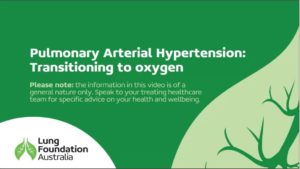In this video, Zuzana Doneley (Clinical Nurse Pulmonary Hypertension, RBWH) shares her expert knowledge on transitioning to oxygen therapy. She answers commonly asked questions about what oxygen therapy is, the different types of oxygen devices, the application process, the benefits and disadvantages of oxygen therapy, and more.
Oxygen therapy is used for patients with low oxygen levels, a condition known as hypoxemia. Normally, oxygen is delivered to the bloodstream through the lungs and then to the tissues. However, if there are issues with the lungs or heart, this process is disrupted, leading to insufficient oxygen levels. In such cases, a specialist doctor may prescribe oxygen therapy.
Oxygen therapy can be temporary, such as during a hospital stay for an infection, or long-term if oxygen levels do not improve. Tests like the six-minute walk test and arterial blood gas analysis help determine the need for oxygen therapy. It’s important to note that not all patients with shortness of breath require oxygen; the need is based on specific tests and physician recommendations.
Patients may need oxygen continuously, during sleep, or only during activities like exercise or travel to high altitudes. Smoking is a major contraindication for home oxygen therapy due to the fire risk. Various devices are used for oxygen delivery, including oxygen concentrators and portable oxygen cylinders. These devices must be used and stored safely, away from heat and out of reach of children.
Applying for oxygen therapy involves completing forms and meeting criteria, such as having a healthcare or pension card. The process includes an initial assessment and regular reassessments to ensure the correct prescription. Patients may also be eligible for electricity rebates due to the power usage of oxygen concentrators.
Side effects of oxygen therapy include dry and sore airways, which can be managed with water-based lubricants and regular equipment maintenance. Travelling with oxygen requires careful planning and coordination with healthcare providers and airlines. Oxygen therapy can significantly improve energy levels, reduce fatigue, and enhance overall quality of life.
Was this page helpful?
Good job! Please give your positive feedback
How could we improve this post? Please Help us.




